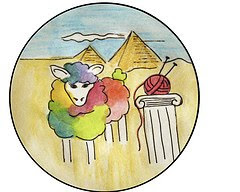Here is a perfect example of how gauge and stitch count can make the same yarn behave in different ways.
This is my first attempt at the Rib Fantastic Socks (Ravelry link).

Because Handmaiden Casbah tends to be on the heavy side of fingering weight I chose to knit the 60-stitch version on 2.25 mm needles. Note how certain colours cluster together and spiral down the sock. Now, while I don’t mind striping I am not too crazy about spiraling so I thought I’d give it another go. I picked up the second cake of yarn and cast on again.
This time I changed everything: needle size, stitch count, pattern. I cast on 63 stitches for the Braided Gem Socks (Ravelry link) on 2 mm needles. The results (not pictured here—I didn’t know that it was going to turn into a blog post) were somewhat better. The greater number of stitches meant that the colours were not stacking up on themselves quite so much but I quickly concluded that while I want to knit this pattern one day, this was not the time or yarn for it.
Well, they say three times is a charm. Now, having experimented with smaller needles and a higher stitch counts, I knew that a) the yarn did not feel like cardboard when knit at a tighter gauge and b) the colours were more evenly distributed when knit over a larger number of stitches. I decided to try Rib Fantastic once again, this time casting on the 66-stitch version on 2 mm needles. Voila!
This time I changed everything: needle size, stitch count, pattern. I cast on 63 stitches for the Braided Gem Socks (Ravelry link) on 2 mm needles. The results (not pictured here—I didn’t know that it was going to turn into a blog post) were somewhat better. The greater number of stitches meant that the colours were not stacking up on themselves quite so much but I quickly concluded that while I want to knit this pattern one day, this was not the time or yarn for it.
Well, they say three times is a charm. Now, having experimented with smaller needles and a higher stitch counts, I knew that a) the yarn did not feel like cardboard when knit at a tighter gauge and b) the colours were more evenly distributed when knit over a larger number of stitches. I decided to try Rib Fantastic once again, this time casting on the 66-stitch version on 2 mm needles. Voila!

No flashing. No pooling. No spiraling.
The moral of this story? If at first you don’t succeed, try, try again. If your variegated yarn does not initially appear to be compatible with your pattern of choice, try tweaking your needle size or stitch count or both. Sometimes, of course, no amount of experimentation will yield the desired results and then it’s time to consider a different design entirely. I believe that for every skein of hand-painted yarn there is a pattern out there that will show it off to its best advantage; sometime it just takes a while to find it. I have several skeins of my own that are patiently waiting in the stash, dreaming of the day they meet Mr. Right.
The moral of this story? If at first you don’t succeed, try, try again. If your variegated yarn does not initially appear to be compatible with your pattern of choice, try tweaking your needle size or stitch count or both. Sometimes, of course, no amount of experimentation will yield the desired results and then it’s time to consider a different design entirely. I believe that for every skein of hand-painted yarn there is a pattern out there that will show it off to its best advantage; sometime it just takes a while to find it. I have several skeins of my own that are patiently waiting in the stash, dreaming of the day they meet Mr. Right.



1 comment:
A very good lesson for us all. Pretty sock.
Post a Comment